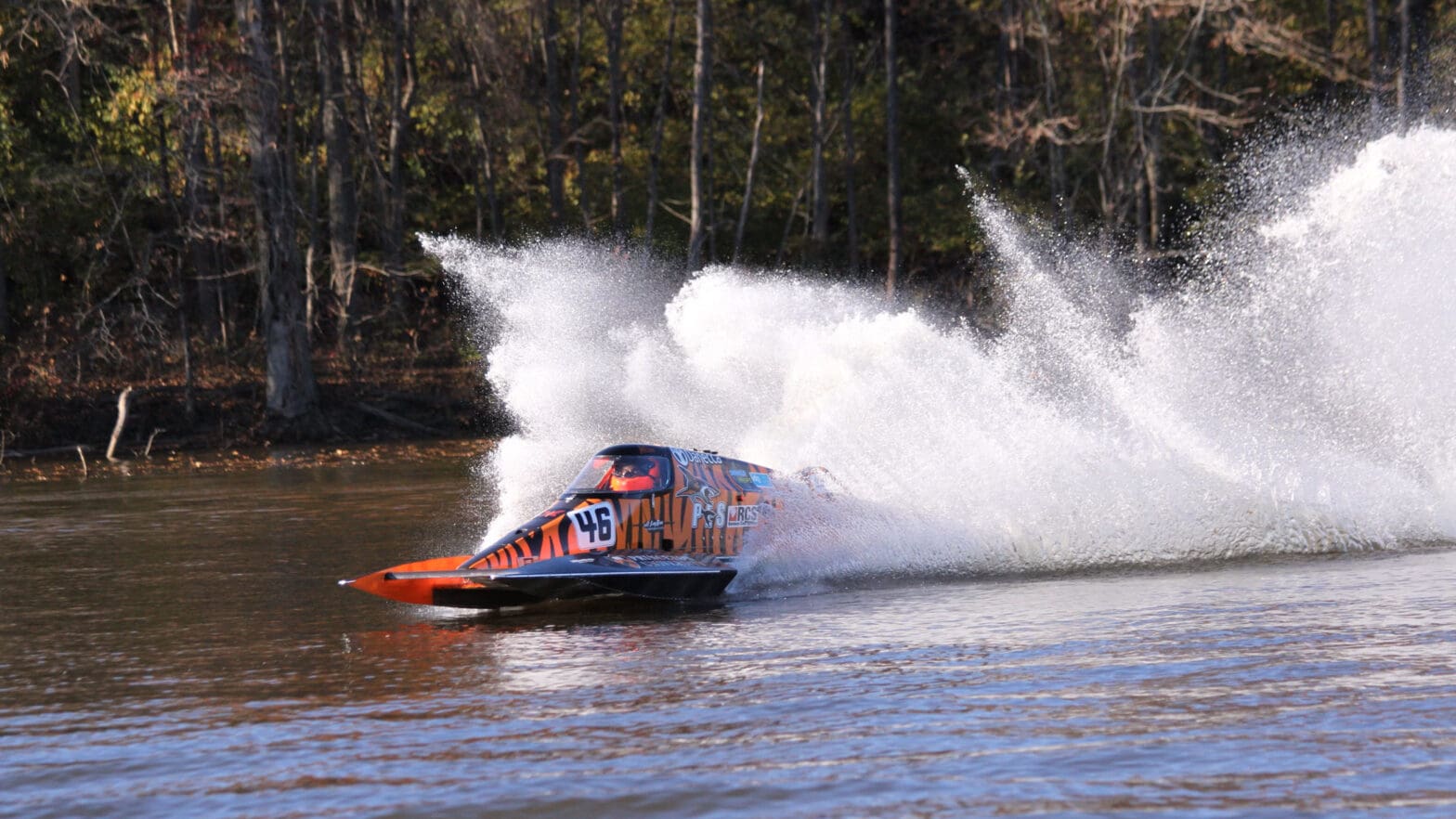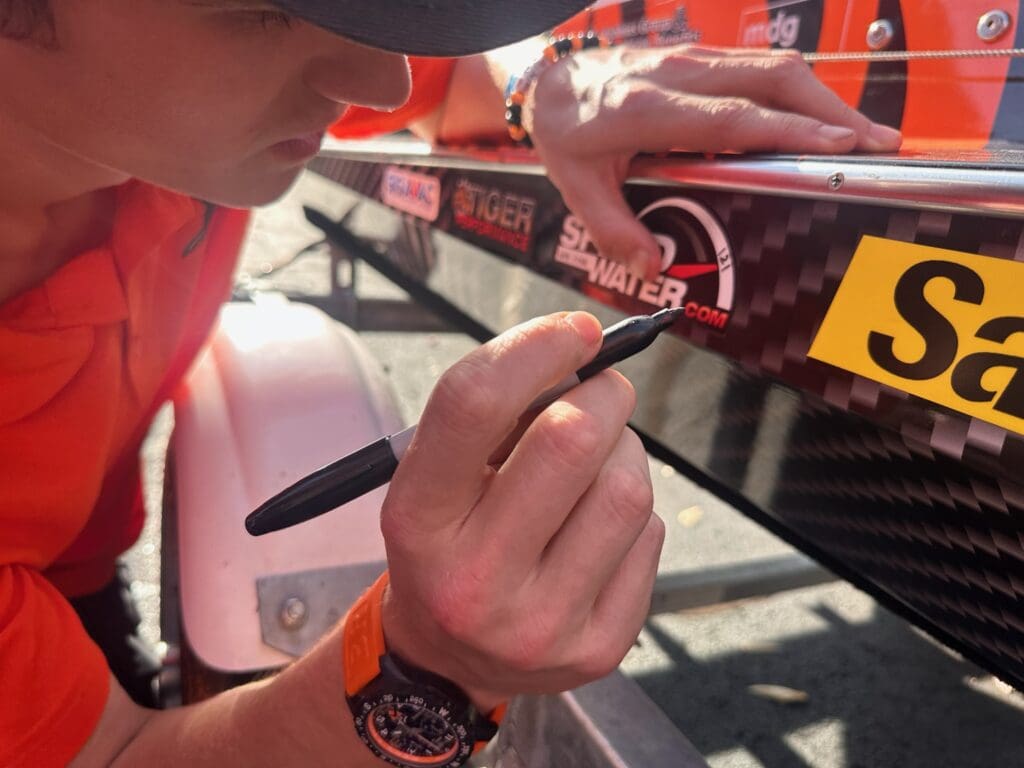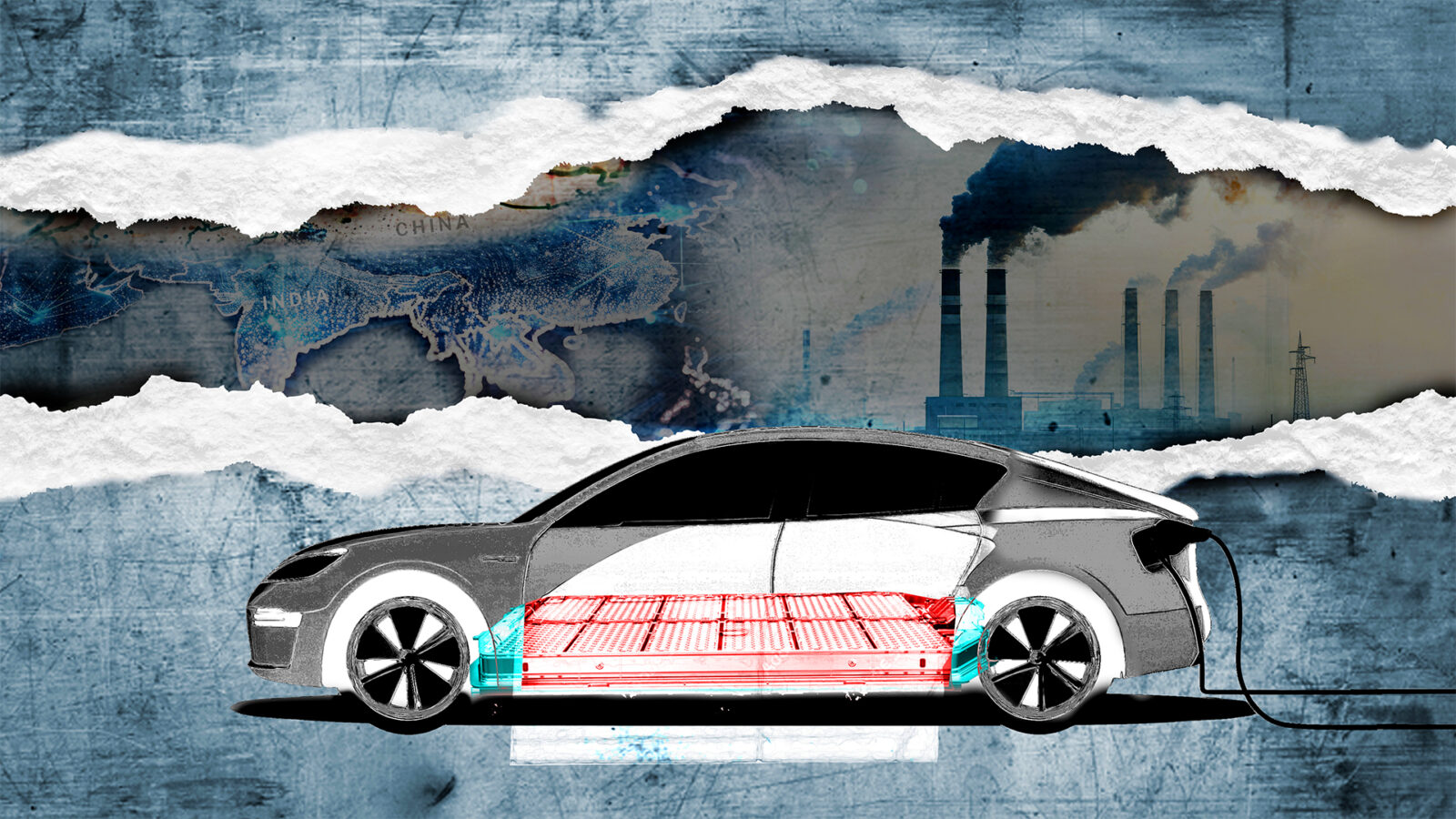
Princeton’s student team broke the world speed record for electric boats
By
on
“Phenomenal,” said team captain Andrew Robbins, a junior majoring in mechanical and aerospace engineering.
The Princeton team set the new record on a 1-kilometer course on Lake Townsend outside Greensboro, N.C. Piloted by veteran speedboat captain John Peeters, the Princeton boat made one pass through the course at 111 mph. Without recharging the batteries, Peeters made a return pass at over 117 mph. The average speed of 114 mph surpassed the previous record of 88 mph set by the automotive company Jaguar in 2018.

Princeton Electric Speedboating, a student-run team made up of 44 undergraduate and graduate students, represents most engineering disciplines as well as members studying economics and physics. The students conducted much of the engineering, design, and fabrication of the boat and of the engine that propelled it to the record-setting run.
Luigi Martinelli, the team’s faculty advisor, said Princeton Electric Speedboating is completely run by students. An expert in computational fluid dynamics and aerodynamic design, Martinelli said that while faculty members offer advice, the students manage the club’s organization, engineering, and finances.
“The students are in charge,” said Martinelli, a professor of mechanical and aerospace engineering.
The Princeton team broke the record using a 14-foot outboard boat called Big Bird. With a hydroplane hull resembling a stealth fighter plane skimming over the water, Big Bird is equipped with a three-phase, 200-horsepower electric motor designed by the Princeton team and built in coordination with Flux Marine of Rhode Island.
The team also took first place in the 2023 national collegiate competition Promoting Electric Propulsion. The competition, organized by the American Society of Naval Engineers and sponsored by the U.S. Office of Naval Research, is held in Virginia.
Robbins, who piloted the boat in that competition, said team members were thrilled with both results. He said they plan to make further adjustments to the boat and improve on the results in the future.
A quick climb to high speed
Princeton Electric Speedboating started in the fall of 2020, when junior Nathan Yates read an open invitation for participants in the Promoting Electric Propulsion competition. Yates, a freestyle sprinter on the Men’s Swim Team, said the requirements for participants were simple.
“The boat had to be all-electric and look like it wouldn’t be a health hazard,” he said.
Yates brought in four friends, including one Rutgers student, to work on a design. Because of COVID lockdowns, Yates commissioned the teammates to handle the project modularly—each member building portions of the boat in California, Oregon, New Jersey, and Rhode Island. They bolted the powertrain together just ahead of the competition in the summer of 2021.

“Two days before the race in Baltimore, we got together in the hotel and spent 48 hours straight soldering. The motor turned on, and it spun,” Yates said. “We bolted it into the hull and off it went, but 20 yards off the dock, the driver was ankle deep in water. The hull turned out to be undersized and we had to pull it back in.”
The team went back to Princeton a month later and switched hulls, with no changes to the powertrain, and the boat ran 27 mph. Eventually, that boat was turned into an autonomous boat called Le Papillion. The team then obtained another racing hull called Tiger, which would be converted to electric and run at 42 miles per hour.
In September of that year, Yates recalled an early meeting in which Robbins, then a first-year student, approached him with a proposal.
“He said, ‘Tiger used to run 95mph all day long as a gas boat. I think if we can power Tiger up, or build a more powerful boat, we can take down the world record—which is only 88mph’,” Yates said. “This was right after our first race, where we didn’t even finish. But I was sold. I could see the math and the vision—it was absolutely doable. There was some serious pushback from the team, however.”
A few months of argument and discussion followed, but team members eventually warmed up to the idea. It seemed unlikely, almost crazy, but everyone agreed, when Yates said that “it was a cool idea.”
“I called Andrew about 2 a.m. one Friday night,” Yates said. “I said find me a new hull.”
Robbins, a Michigan native with a background in speedboating, made a series of calls to boaters and connected with J.W. Myers, a veteran racer and the owner of Black Sheep Racing in South Carolina.
“He said, ‘I think I know just the hull for this,’” Robbins said. “The boat was called Big Bird.”
Big Bird is a well-known craft in racing circles. Designed by legendary boat builder Ed Karlsen, the boat had set several important records using a gasoline-powered engine, and was being stored in Detroit, Robbins said.
“J.W. knew it was fast, it was safe, and it would do what we needed it to do,” Robbins said. Coincidentally, the boat was “about an hour from my house.”
Big Bird is a hydroplane hull. It sits low on the water with an enclosed cockpit for the driver. At high speeds, the structure generates lift so the hull planes above the surface, tilting back until only a small section of the stern remains in contact with the water. Robbins said the team worked with Black Sheep to make modifications and repainted the hull in Princeton black and orange.
For the motor, batteries and drive train, the team worked with Flux Marine. The company, based in Narragansett, Rhode Island, was co-founded by Ben Sorkin, who graduated from Princeton in 2017 with a degree in mechanical and aerospace engineering. Sorkin began working on the electric propulsion concept as an undergraduate and began developing the plan for Flux Marine as a participant in the Keller Center’s eLab Accelerator program.
“It became a great relationship,” Sorkin said about working with the current students. He recalled testing his own electric boat on Lake Carnegie as an undergraduate and has since hired Princeton engineering students as interns and full-time engineers.
As the student club worked to adapt Flux Marine’s system for the Big Bird hull, Sorkin said the students’ enthusiasm was infectious and engineers spent late nights working on the design.
“What I loved about these kids was the attitude,” he said. “They never got frustrated. They just went back and worked harder.”

Much of the fabrication work for the drive train was performed on campus. Robbins said teammates spent hours in the MAE laboratory in the basement of EQuad adapting and creating parts for the boat. He said lab managers Glenn Northey and Al Gaillard provided critical assistance with the machinery, and student teams created simulations and performed computer-assisted design work. Most of the assembly work on the 14-foot boat was conducted at the Forrestal Campus.
Yates said the team had to clear out old equipment from garage at Forrestal to free workspace for the boat. Among the old equipment and parts was a large orange flag that the team adopted as signal for test runs. The shore team used it to alert the driver to hazard or signal a return to the dock.
“I am not sure if it was from a previous team or it was a professor’s,” Yates said. “We decided to save it for testing.”
In March 2023, with permission to use Lake Carnegie, the team launched Big Bird for a test run. Yates, who had returned to Princeton after graduation to secure a master’s degree in engineering, said the result was not encouraging.
“It ran 7.2 mph,” he said. “We were pretty devastated.”
The crew went back to work. They searched for problems and switched out parts. More testing and modifications steadily improved performance. In August, the team ran a test run in Maryland. With some additional adjustments to the boat’s trim and drive placement, they reached an unofficial speed of 98.6mph. The record was within reach.
In October, the team traveled to Greensboro with an 18-person crew. Yates said everyone had a job to perform, from preparing Big Bird to observing the runs from pontoon boats on Lake Townsend. Two pontoon boats were stationed near the course with camera operators, race officials and team members.
Peeters took off from the shore with a low whine from the motor. As the boat picked up speed, it leveled to glide over the water’s surface. As Big Bird accelerated toward the course entry, it kicked up a rooster tail of white water.
Neither Robbins, in charge of the crew on shore, or Yates, live streaming the event, could see the course. They kept their eyes on Myers, who was using a walkie talkie to get times from the race officials. A team member stood next to Myers with the orange flag.
“That flag was the signal,” Yates said, “and we could see it waving. We knew we had the record.”







